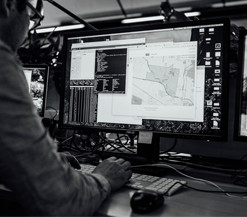In this blog, Fivecast Senior Tradecraft Advisor, Jeff Fehmel, uncovers how increasing isolation and despair present as a common theme amongst threat actors in the lead up to acts of mass violence and how OSINT can play a role in identifying dangerous individuals before it’s too late.
IDENTIFYING POTENTIAL TRIGGERS
The current group of mass shooters are fueled by hopelessness. As the pace of mass violence continues in America, it is necessary to see that searching for the blatant threats of violence or extremism is not sufficient to identify lone wolf attackers and we need to adjust the warning signs we look for.
Rarely do these attackers try to evade law enforcement, instead they are usually captured or killed shortly after they pull the trigger. Despite this homicidal and suicidal action, attackers are not always ‘crazy’ in the traditional or legal sense. There is a sufficient sense of calculation and an awareness of their actions proven after the fact to indicate the actor knew the difference between right and wrong. Many are desperate enough to act regardless of consequence or have given up continuing to live in society.
While their reasoning and conclusions are often steeped in delusion, the feelings they have are very real, and come from a real place of insecurity, anger, and hopelessness. Examining these emotions presents an opportunity to identify potential attackers before it is too late.
LEARN MORE:
Request the violent extremism threat monitoring case study to understand how OSINT can be used to identify networks and evaluate extremist intent and risk.
The path to mass violence
Hateful rhetoric is not the only thing to keep watch for when examining potential mass shooters. Often, the deeper cause is despair and desperation. Despair, in all its forms, becomes a driving force toward extreme violence. Economic, social, and emotional hopelessness are almost universally present in the lives of those who carry out mass violent attacks.
The Buffalo shooter, Payton Gendron’s manifesto contains pages and pages of pseudoscience justifying his actions but his fear and despair toward ‘White Replacement’ is the core of his actions. His rhetoric is hateful, but his fear of what he sees as America’s future is the true driving force.
Hate is present, but rarely the sufficient single motivator for the kind of mass casualty violence that has become increasingly common in the last decade. Most of these attackers are aware that their life will effectively (and often literally) end with their attack, but in the aftermath, it is rare that hate stands as the sole motivation for someone to throw their life away. Fear, whether direct or existential, desperation and despair are far more direct catalysts for violence, when there is no hope for the future, throwing one’s life away does not seem like much of a cost. This leads to a sense of hopelessness and can come from many aspects of life and can possibly lead someone down the path of violence – ‘just one more thing’ that can lead to ‘the one last straw’.
The despair that comes from economic inequality and the inability to support oneself can lead many down the path of extremism. The inability to form relationships – both romantic and platonic – can drive people mad, whether they become incels or simply angry and alone. Taking the ‘black pill’ is often the final step incels take, becoming despondent and resigned to the notion that they’ll never find a romantic partner.
Perpetrators are often depressed, suicidal, or generally mentally unwell – but not so much that they lack that basic reason or understanding that what they are about to do is wrong. They’re usually socially isolated and often hostile or aggressive toward others. These are the warning signs to look for to head off the next mass shooting. Some examples of tragic mass shooting incidents where despair and frustration were potential motivators include:
| Date | Perpetrator | Outcome |
|---|---|---|
| June 5, 2017 Orlando, FL | John Robert Neumman Jr. | Killed 5 staff at his former workplace. Died from self-inflicted gunshot wound. |
| November 5, 2017 Sutherland Springs, TX | Devin Patrick Kelley | Killed 26 people and wounded 22. Died from self-inflicted gunshot wound. |
| January 28, 2018 Saltlick, PA | Timothy Smith | Killed 4 people, including ex-girlfriend. Died from self-inflicted gunshot wound. |
| June 1, 2022 Tulsa, OK | Michael Louis | Killed 4 people, including his doctor. Died from self-inflicted gunshot wound. |
| Examples of Mass Shootings in the US | ||
Where is the despair coming from?
At the macro societal level, the stagnant nature of politics and rapidly declining economic opportunities can lead many to think that there is no peaceful solution to the world’s issues. The belief that the world – and by extension their life within it – is getting worse, with no solution in sight can lead many to abject despair. ‘Doomers’ have become common posters in online forums, adding another facet to the extremist beliefs often held on these sites that can nurture that sense in the individual that they must ‘act’, often in a misguided sense that they are saving others through their sacrifice.
Growing isolation is a major factor in the trend. While the size of Americans’ social circles is declining across the board, the trend is far more pronounced among men, with fifteen percent reporting no close friends at all. The aftershocks of the pandemic, as well as the growing ubiquity of the internet has certainly played a part, but the growing economic uncertainty among many Americans is making it difficult to justify the cost of offline social interactions – living paycheck to paycheck walls off many of the traditional options men have to socialize. Critically, the internet now provides a more effective echo chamber than in-person relationships.
Fivecast’s OSINT capabilities are a valuable tool for intelligence teams to quickly identify threat actors, identify risk and evaluate intent. Fivecast ONYX uses an advanced AI-enabled risk detection framework to detect whether a person of interest has a tendency towards extremist material and high-powered weaponry. To learn more about extremism and how Fivecast can assist your organization to protect the community, request a demo.




